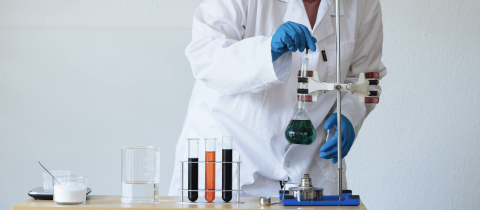"I collected the instruments of life around me, that I might infuse a spark of being into the lifeless thing that lay at my feet." With these words Victor Frankenstein began his account of the adventure that would terrify generations of readers. Although Mary Shelley's classic 1816 tale is usually thought of as a horror story, it is actually a thoughtful fantasy about the consequences of science gone astray. What prompted an eighteen-year-old girl to write such a dark, scary story about creating life? Works of fiction are often born out of some real life experience. So it is interesting to muse about what actual events may have triggered the concept of Frankenstein.
First, let's get one thing straight. Frankenstein was the creator, not the monster. And he was not a doctor. Neither was he a "mad scientist." Victor Frankenstein was a university student who from a young age had been obsessed with a search for the secrets of heaven and earth. He voraciously read the works of the great alchemists like Albertus Magnus and Paracelsus who tried to find the secret of everlasting youth. He became fascinated with the power of electricity when he saw a tree split by a lightening bolt.
The death of his mother prompted Victor to search even more vigorously for the secret of life. Finally, after numerous failed experiments, he managed to breathe life into the famous creature that he had assembled from body parts. Mary Shelley does not describe the details of the creation; there is no mention of bubbling flasks or electrical generators. All of that was added by the moviemakers. In fact, Mary's creature is not a monster! Quite unlike the Boris Karloff incarnation, he learns to think and converse intelligently. It is only when society shuns him because of his appearance that he turns violent. Victor Frankenstein had unintentionally unleashed a scourge on society!
Was Mary Shelley herself worried about what unbridled science might unleash? Perhaps. Mary married Percy Bysshe Shelley, who had left his wife and children for her. One of their first outings together was to a public lecture in London about the medical uses of electricity and “galvanism.” Luigi Galvani in Italy had discovered that touching a severed frog leg with metal instruments caused the leg to quiver! He wrongly interpreted this phenomenon as "animal electricity." Actually he had accidentally set up a battery with two dissimilar metals acting as terminals and the frog's fluid as electrolyte. The demonstration of galvanism had quite an impact on Mary. Apparently she even had a dream that a stillborn baby was brought back to life by electricity. Why did Percy drag Mary to a scientific lecture? Because he had become keenly interested in chemistry as a student at Eton thanks to his mentor, a Scottish natural Philosopher by the name of James Lind (1736-1812). Lind had obviously excited students with chemical experiments because one of Percy Shelley’s biographers recounts how his rooms at Oxford were cluttered with chemical equipment. But Lind also had developed a passionate interest in “animating” dead limbs with electricity. Indeed, Lind was the first British scientist to repeat Galvani’s experiments, possibly in the presence of Percy Shelley.
Certainly Lind did not think that electricity could bring the dead back to life but he did tinker with the idea of using electricity to treat illness. He even suggested that it might be tried to treat the madness of King George! Christopher Goulding, a researcher in English literature at the University of Newcastle goes as far as to suggest that Dr. Lind may have served as the model for the character of Victor Frankenstein. He also draws some interesting parallels between the character of Waldman, the chemistry lecturer who so fascinates Frankenstein and Lind. In any case, it is very likely that one way or another, Percy Shelley’s encounter with Dr. Lind played a significant role in the creation of Frankenstein.
Mary and Percy Shelley left England, probably because of the scandal surrounding their marriage and took a boat tour down the Rhine River in Germany. Here they apparently stopped at a castle which had become a tourist attraction because of the exploits of a former inhabitant by the name of Johan Conrad Dipple. Dipple was a seventeenth century alchemist who pursued knowledge relentlessly. Shades of Victor Frankenstein! Rumor even had it that he dug up graves and collected cadavers for macabre experiments. He had been passionate about finding out how the body worked. He even created "Dipple's Oil," which supposedly prolonged life. Dipple may have died from tasting his own concoctions since he is known to have met his demise foaming at the mouth and convulsing. The name of the castle? Castle Frankenstein!
The Shelleys also stopped at another tourist attraction on the Rhine, a museum featuring "automata." These were ingenious clockwork dolls created by master craftsmen. Some survive to this day and still amaze people with their life-like antics. So the stage was set. Mary had been impressed by galvanism. She had visited castle Frankenstein and learned about Dipple's efforts to create life. The automata she had seen looked practically alive. It is therefore little wonder that when she, her husband and two friends forced inside by the cold Swiss weather got into a game of writing horror stories, Mary produced the classic Frankenstein. She also left us with an important legacy about the need to think carefully about the consequences of science, whether that be assembling body parts or molecules!







